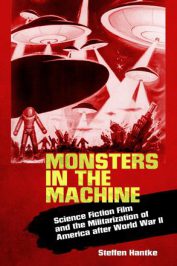The 1950s and 1960s were the decades when science-fiction movies boomed and during that time not so much technology, but disgust, shock, fear, basically all aspects of horror and horror movies, were used instead to give science fiction movies a certain direction by presenting miniature or giant creatures, mutants and every kind or harrowing creature that would make an audience scream.
 We must not forget then, that the majority of all 1950s scifi movies are connected to gothic literature, in particular to Shelley’s original Frankenstein; in the gothic tradition of the 19th century horror and science fiction were still united. But while the “modern” scientists of the 1950s movies worked in teams and research groups; their fictional ancestors were loners, often described as, well, suspicious characters who worked in the dark in strange, remote places like old castles and hidden underground research labs.
We must not forget then, that the majority of all 1950s scifi movies are connected to gothic literature, in particular to Shelley’s original Frankenstein; in the gothic tradition of the 19th century horror and science fiction were still united. But while the “modern” scientists of the 1950s movies worked in teams and research groups; their fictional ancestors were loners, often described as, well, suspicious characters who worked in the dark in strange, remote places like old castles and hidden underground research labs.
This is just one feature that leads towards Hantke’s basic theme in the book: that the US military with all its branches not only comes to the (successful) rescue of all mankind, but that the organized, devoted and loyal aspects of the military have nothing but positive effects so that they should be part of everyday civilian life in the US as well.
Already in the 1940s, the military very willingly offered help for movie productions by presenting ships, tanks or planes for scenes, since this was one easy way to introduce (and market) the armed forces. As many war-time productions already were based on a strong cooperation with the military, having soldiers populate film sets was not a surprise for an audience.
The 1950s in the US were a decade when “Monster movies” were highly in demand; they represented the opposite of mainstream Hollywood film production. In all the (monster movie) turmoil that was inspired by real anxieties in the US, the military-industrial complex played a significant role and would emerge most likely in all the movies to reinstall order and faith; at least, they tried. “Holding together the cultural diversity, the rich phantasmagoric tapestry, of 1950s America is the tight framework of the Cold War, and thus of the military.”
Still in the majority of the 1960s monster films, finally the military comes in and successfully drives back alien invaders of all shapes and sizes. Needless to say that this group is always pictured as heroic, daring and patriotic; and the script usually leaves no doubt about those motives, while, on the other hand, of course militarization, warfare and violence were promoted. This was the main function of the military presence in many of those movies: to prepare the American people for a future war, fought with conventional or nuclear weapons, that might start anytime. We must not forget that – in reality – the Cold War easily could have turned into a hot one.
Little wonder then, that often service life, violent conflicts, soldiers as characters and military chains of command were brought in. WWII had ended only in 1945, while the war in Korea was still in full swing when some of the movies were made. Therefore, armed service personnel, uniforms, and military jargon were part of everyday life in the 1950s. It was neither exotic nor old-fashioned. The overall feeling was that the next war was just around the corner and both the military, and the people had to be ready; and apart from a delicate and small anti-war movement (to become stronger by the early 1960s), nobody really objected. Looking back at this development today, we may think of this as aspects of a country at war, or a country expecting invaders very minute.
Concurrently, this militarization was one aspect of a totalitarian system like the one in the USSR at the time. However, the science fiction movies of the period were also produced to earn money. So whenever “…the actual realities of war might sour an audience or the enjoyment of imaginary wars, cinematic genres capable of generic displacement seem to flourish. From the safe distance of metaphor or allegory, they comment on historical events that are too close to discern clearly, too frightening to contemplate, or too painful to remember for any literal representation.”
In addition to an excellent introduction, Hantke’s chapter on “Decolonization,” a real image of the US politics abroad (basically the Third World) is indeed worth reading. There he very convincingly shows the expansion of the American military-industrial complex into other countries and the strong involvement in postcolonial conflicts; which leads to another disguised theme, namely paranoia, in science fiction films during the Cold War. While the US felt it necessary to keep an open eye for intruders even in remote and exotic countries thousands of miles away from the US mainland, the USSR was moved with similar paranoia (and brutal military force) to keep its satellite states under control.
Hantke’s last chapter evaluates the science fiction movies of the 1990s and the post 9/11 productions of the genre; or rather how those movies deal with the long shadow of the genre films from the 1950s.
With the emphasis on the military and its influence on civilian life, this study on horror/science fiction movies brings a lot of fresh energy to the evaluation and appreciation of this movie variety.
Review by Dr. A. Ebert © 2018
Steffen Hantke. Monsters in the Machine: Science Fiction Film and the Militarization of America after World War II. University of Mississippi Press, 2016, 240 p.
